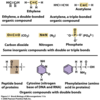Chapter 1,2,3 Flashcards
(105 cards)
What is Microbiology?
The study of organisms too small to be seen by the unaided eye (can see object 1 nm in Diameter,cannot perceive less than 0.1in Diameter)
Bacteriology?
study of Bacteria & Archaea
Mycology?
study of Fungi,yeast,molds,macro fungi
Phycology?
Study of Algae
Protozoology?
Study of Protozoa
Virology?
Study of Viruses, viroids, Prions
Antony Van Leeuwenhoek(1684)(Dutch)
-Amateur lens maker -made simple microscopes -discovered bacteria,yeast,algae and protozoa(“animacules”) -advancements from Robert hooke)
Fredinand Cohn(1876)(German)
-Father of bacteriology -accurate observations of bacteria -dis. endospores -proved monomorphism of microbes
Louis Pasteur (french)(mid-late,1800’s)
-saved the french beer industry(developed mechanism of fermentation) -chemist(studied optical activity) -Anthrax, rabies vaccine(tried on kid) -Transformation of organic matter due to microbes -discovered anaerobic life -crushed the theory of spontaneous generation(swan necked flask experiment) -early development of germ theory
Pasteur’s Swan necked flask experiment
1- nonsterile liquid poured into flask(neck of flask drawn out in flame, & liquid sterilized by extensive heating) 2-liquid cooled slowly(flask upright position where dust and microorganisms trapped in bend-open end-liquid remains sterile indefinitely 3-Flasked tipped so microorganism-laden dust contacts sterile liquid (liquid putrefies(contamination))
Robert Koch(physician) (German)(late 1800’s)
-proved causation of anthrax -demonstrated biological specificity of disease agents -experimental application of Henle’s principles of infection(“koch’s Postulates”)
Koch’s Postulates
- The suspected pathogen must be present in all cases of the disease and absent from healthy animals. 2. The suspected pathogen must be grown in pure culture. 3. Cells from a pure culture of the suspected pathogen must cause disease in a healthy animal. 4. The suspected pathogen must be reisolated and shown to be the same as the original.
Development of Pure Culture Methods
-Koch first used solid nutrients as potato slice (not everything can grow on)(overgrown molds) -Later used gelatin(drawback was only solid at certain temp.) -finally, agar( from seaweed) which remain with us to this day. (koch got from hesse)
Golden age of Medical Microbiology
-rise -(1876-1900) -Beijerinck & Winogradski
Sergei Winogradsky (Russin)(late 1800-early 1900)
Chemolithotrophy and Chemoautrophy, nitrogen fixation (described the cycles), sulfur bacteria (autotrophic bac.)
Martinus Beijerinck (Dutch)(late 1800-early 1900)
Enrichment culture technique, discovery of many metabolic groups of bacteria, concept of virus(smaller than bac.)
Growth of microbiology in 20th century
-characterizing agents of infectious disease -study of immunity and relation to disease -search of chemotheraputic agents -chemical activities of microorganisms -Contributed significantly to the rise of biochem.
1941- Beadle & Tatum
Biochemical mutants of the fungus (Neurospora)
1943- Delbruck & Luria
Mutations in bacteria( inheritance characteristics)
1944- Avery, Mcleod, & McCarty
Bacterial transformation, DNA is hereditary material
Six characteristics of Living Cells(cell based systems)
- Metabolism 2.Reproduction 3.Differentiation 4.Communication 5.Movement 6. Evolution
1.Metabolism
uptake of chemicals from the environment, their transformation within the cell and elimination of wastes into the environment. The cell is thus an open system.
- Reproduction(growth)
chemicals from the environment are turned into new cells under the direction of preexisting cells.(mother cell to daughter cells)
- Differentiation
Formation of a new cell structure such as a spore usually as part of a cellular life cycle.(life boats-no increase in population - survival mechanism)










